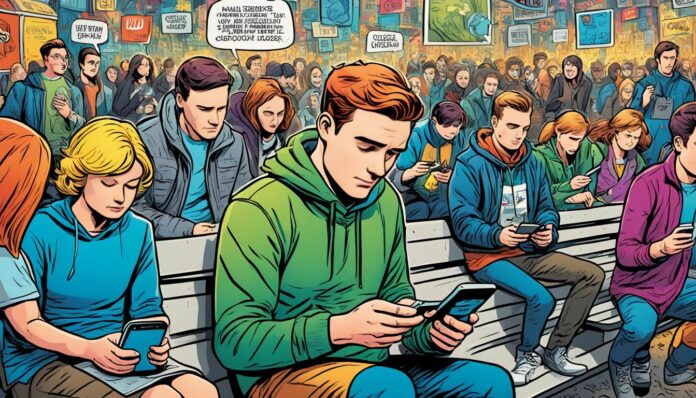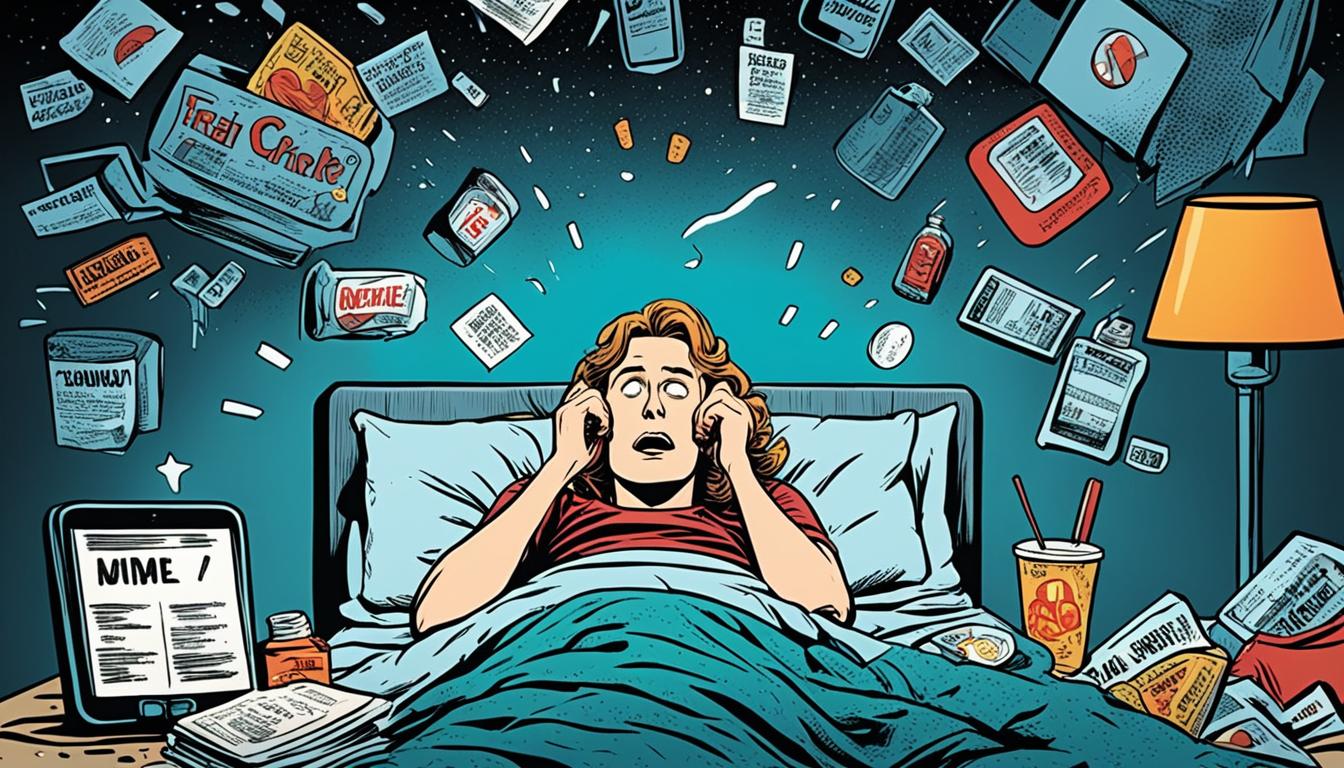
Smartphones and social media have changed how Generation Z feels. In the U.S. and other developed countries, we see signs of a crisis. This crisis affects the mental health and growth of today’s young people.
Studies show that depression and anxiety in the U.S. went up by more than 50% from 2010 to 2019. Suicides among teens 10 to 19 went up by 48%. For girls 10 to 14, it jumped by 131%. These trends are seen in Canada, the U.K., Australia, New Zealand, and the Nordic countries too.
There’s also been a drop in how well students do in school, especially in reading and math in the U.S. since 2012. Young adults now feel lonelier and less interested in social activities like dating and having kids.
Key Takeaways
- Rates of depression, anxiety, and suicide have skyrocketed among Gen Z, with a disproportionate impact on young girls.
- Academic achievement has declined, and social relationships have become more fragmented, with young adults showing less interest in traditional milestones.
- The widespread adoption of smartphones and social media has coincided with these concerning trends, raising questions about their potential role in the well-being of today’s youth.
- Parental control apps, screen time limits, and educating children on the risks of digital addiction and cyberbullying are crucial steps to mitigate the negative impact of smartphones.
- Establishing stricter guidelines and later thresholds for smartphone use can help children develop healthy coping mechanisms and limit their exposure to potential mental health risks.
The Decline of Play and Independence
The digital age has changed childhood a lot. Traditional ways of playing, taking risks, and being independent are fading away. Sociologist Jonathan Haidt says the play-based childhood is disappearing. This change started in the early 2010s with smartphones and social media becoming more common.
Haidt’s book, “The Anxious Generation,” points out some worrying trends. He thinks kids shouldn’t have smartphones until high school and no social media until they’re sixteen. He believes these technologies have made more teens feel depressed and anxious. The way smartphones work changed a lot after 2008 with the App Store and push notifications. This led to more distraction and less learning and social growth.
The drop in play and independence is linked to overprotective parenting. Haidt says this started in the 1980s. It led to a big change in childhood in the early 2010s. Since then, teen mental health has gotten worse.
“The new phone-based childhood is negatively impacting young people, hindering their progress toward adulthood flourishing.”
Sociologist Jonathan Haidt talks about the bad effects of the digital age. These include not being able to focus, less learning, getting addicted to the internet, feeling lonely, and losing meaning. The drop in play and independence, often because of smartphones, is bad for kids’ well-being and growth.
The Impact of Smartphones on Adolescent Mental Health
Smartphones and social media have changed how teens think about themselves and their world. Smartphone addiction and too much screen time have made mental health problems worse for adolescent development.
The Ontario Student Drug Use and Health Survey (OSDUHS) from 1991 to 2017 showed a big rise in mental health issues among Ontario students. A study also found that more young people in Canada were harming themselves. In the US, suicide attempts by young people went up from 2000 to 2018.
Studies in the US from 1991 to 2018 showed more teens were feeling depressed. Data from 2005 to 2017 pointed to trends in mood disorders and suicide. The 2014 Ontario Child Health Study found more teens were thinking about suicide and trying to take their own lives.
Smartphones and social media affect teens in many ways. Social media use is linked to not sleeping well in students 11 to 20 years old. Using eReaders at night also affects sleep and how alert you feel the next day. Research shows that too much internet use might lead to self-harm or suicidal thoughts in teens.
Too much screen time has changed childhood in a big way. It has led to more depression, anxiety, self-harm, and suicide in teens. With 24 percent of teens always online and 73 percent with a smartphone, their mental health is clearly suffering.
Experts in mental health want rules for how much screen time teens should have. They believe this will help fight the bad effects of smartphone addiction and social media on adolescent development and mental health.
The Gender Divide in Smartphone Usage
In the early 2010s, smartphones became a big part of teens’ lives. Girls started using visual social media like Instagram, Pinterest, and Tumblr more. Boys, on the other hand, preferred video games and YouTube. This difference in how they used smartphones affected their mental health and physical activity.
The Effects of Social Media on Girls
Social media’s focus on emotions and images deeply affected girls. They faced more anxiety, depression, and self-harm. The need to look perfect online and fear of missing out hurt their mental health.
The Attraction of Video Games for Boys
Boys were drawn to video games and online videos. These activities let them express their interests and feel part of a community. But, they also led to less physical activity and social isolation. Spending too much time gaming meant less time for real-life friends and exercise.
Understanding how smartphones affect teens differently is key. Parents and teachers need to help both girls and boys. They should find ways to balance tech use with real-life experiences.
| Metric | Girls | Boys |
|---|---|---|
| Preferred Digital Activities | Social media platforms (Instagram, Pinterest, Tumblr) | Video games, YouTube |
| Mental Health Impacts | Higher rates of anxiety, depression, and self-harm | Increased physical inactivity and social isolation |
| Key Concerns | Constant comparison, validation-seeking, and fear of missing out | Addictive nature of video games and neglect of offline social interactions |

“The impact of smartphone use on teenage minds varies based on how smartphones are used, what activities teens neglect due to smartphone use, and the social context in which smartphones are utilized.”
Child’s Smartphone Ruining Their Life
Smartphones and social media have changed childhood deeply. They pulled kids into a virtual world that seemed safe but is actually more dangerous. Parents now feel they can’t control their kids’ use of smartphones and social media.
Research by Jean Twenge, a psychology professor, shows that iGen, born between 1995 and 2012, spends a lot of time online. They have less face-to-face time with friends than past generations. Twenge’s findings link more screen time with more unhappiness and suicide in teens.
Children’s mental health and happiness have taken a hit. Mental health issues, depression, and suicide among teens are rising. This is especially true during times like the COVID-19 pandemic when they’re online more.
- Suicide deaths among kids ten to fourteen doubled from 2007 to 2017.
- More social media use links to more anxiety and depression, especially in girls, Black kids, and LGBTQ youth.
- Boys, influenced by porn and video games, also struggle with mental health from social media.
Young people are becoming more fragile mentally. They lack real-world challenges and risk-taking. This makes them more anxious and intolerant.
To fix this, we need more free play for kids. No smartphones before high school. No social media before sixteen. And no phones in schools. These steps can help build resilience and mental health in the next generation.
| Statistic | Impact |
|---|---|
| Suicide deaths among children ages 10-14 more than doubled between 2007-2017 | Alarming rise in mental health issues and self-harm among young children |
| More social media use linked to higher rates of anxiety and depression, especially in girls, Black children, and LGBTQ youth | Disproportionate mental health burden on marginalized youth |
| Boys influenced by porn and video games also negatively impacted by social media | Widespread mental health challenges across genders due to digital distractions |
Smartphone addiction and digital distractions are harming children’s mental health and resilience. We need urgent action to bring back a childhood focused on play. Limiting technology use is key to protecting the well-being of future generations.
The Tipping Point: A Call for Action
The numbers are clear: more and more young people are struggling with depression, anxiety, and suicide. This is a critical moment for action. Parents must act now to protect their kids’ mental health.
The Four Norms to Solve the Crisis
We suggest four important rules for parents and communities:
- No smartphones before high school
- No social media until age 16
- Phone-free schools
- More independence, free play, and responsibility in the real world
These steps are backed by research and expert advice. They can help bring back a childhood filled with play and protect our kids’ mental health. By following these rules, we can help our youth grow strong in the digital world without losing out on important life skills.
“The decline in ordinary social behaviors, such as face-to-face communication, has been attributed to technology according to research.”
Changing our ways might seem hard, but it’s crucial. Parental action and working together are key to fixing the smartphone restrictions issue. Our kids’ well-being depends on it.
By adopting these rules, we can start a new chapter in how we use technology. We can give our kids back the joys of exploring the world, making friends, and playing freely. It’s time to act – let’s join hands to make a better future for our kids.
The Consequences of Inaction
The mental health crisis among young people is getting worse. If we don’t act, more kids and teens might face mental illness. They could struggle with depression, anxiety, and thoughts of suicide.
This situation is worrying for our future. It could lead to fewer people getting married and starting families. Young people might not be brave enough to innovate and grow in their careers.
“The consequences of inaction are dire. If we fail to address the mental health crisis affecting our youth, the societal impact could be catastrophic, from declining marriage rates to a stagnant economy. We must act now to protect the future of our children and our communities.”
We need to take action fast. By tackling the issues with smartphones and social media, we can lessen the harm. We must act now to protect the mental health of our children and communities.

Restoring a Play-Based Childhood
Smartphones have become a big part of our lives, but they’re hurting kids’ mental health and growth. Taking away play and risk-taking stops their brains from developing right. It also makes it harder for them to learn important social, thinking, and feeling skills.
Now, the average American kid spends over 5.5 hours a day looking at screens, up 17% from 2019. This is a big change from the active, curious play of the past. By bringing back play, we can help kids grow up fully developed.
- Haidt suggests four key recommendations for restoring a play-based childhood:
- No smartphones before high school
- No social media before age 16
- Phone-free schools
- Promoting more independence, free play, and responsibility in the real world
These steps are crucial in a world where 42% of American kids have a phone by age ten, and 91% have a smartphone by age 14. Cutting down on screen time and pushing for active, creative play helps kids get the skills they need to do well in life.
“Restoring play-based childhoods is essential for child development and mental health. By reducing screen time and encouraging real-world exploration, we can help children wire up their brains and acquire vital social, cognitive, and emotional skills.”
Balancing Technology and Real-World Experiences
In today’s world, it’s hard to find the right balance between tech and real-life experiences for kids and teens. Smartphones and digital devices are great for learning, talking, and fun. But, they can also mess with childhood growth and social skills.
Too much screen time can make young people feel anxious, lonely, and less creative. Elizabeth, a school admin in Barcelona, said, “Our school doesn’t allow phones. It helps kids connect and socialize better.” This shows how important it is to limit tech use and encourage real-life interaction for healthy growth.
- Ben suggests waiting to give smartphones and social media to kids. This helps them adjust better during big changes, like moving from elementary to high school.
- Jaleelah, a parent, warns against giving too much screen time to high school freshmen. She knows it’s tough for them to handle the digital world.
- Zack, a teacher, sees more phone use in class. He thinks it hurts how well students pay attention and learn.
Tanner, who got phones and social media too early, wishes he had explored the world more. “I wish I had more time to see the world, not just screens,” he said.
As tech gets more into young lives, parents and teachers must find a balance. Setting limits, promoting physical activity, and building strong connections helps kids grow strong for the 21st century.
Steve Jobs once said, “Technology is nothing. What matters is believing in people’s goodness and smarts. Give them tools, and they’ll do amazing things.” Let’s follow this idea. By teaching good digital habits and real-life experiences, we can help the next generation handle tech with confidence and strength.
Conclusion
This article shows how smartphones are hurting today’s youth. They are losing out on play and independence, and mental health issues are on the rise. We need a big change to fix this problem.
Parents, schools, and policymakers must work together. Parents should wait to give smartphones to their kids and choose simpler devices. They should also limit screen time to keep a healthy balance.
Schools need to teach kids how to play and social skills. This helps kids become strong and well-rounded. Policymakers should make laws and spread awareness to help these efforts. They should push for a society that values childhood over constant digital use.
If we don’t act, the effects could be huge. It will hurt kids and our society’s future. We can still change this by making a move now. Let’s work together to give kids a childhood filled with play. It’s time for change, and we all must lead this important shift.
FAQ
What are the alarming trends in mental health among youth today?
Depression and anxiety in the U.S. have jumped by more than 50% from 2010 to 2019. Suicides among teens aged 10 to 19 went up by 48%. For girls aged 10 to 14, it was even worse, with a 131% increase. This shows a big mental health problem with Generation Z.
How has the “great rewiring of childhood” impacted child development?
Childhood used to be a time for learning and growing through play. But now, kids are losing out on freedom and the chance to take risks. This started in the 1980s and got worse in the early 2010s. It’s changed how kids grow and affects their mental health.
How have smartphones and social media affected adolescent mental health?
Smartphones and social media changed how teens live and grow. Carrying the internet in their pockets changed their friendships, dating, and even sleep. This led to more depression, anxiety, self-harm, and suicide among teens.
How have the effects of smartphones and social media differed between boys and girls?
Boys started playing more video games and watching YouTube when smartphones became common. Girls turned to platforms like Instagram and Tumblr. This led to more anxiety and self-harm in girls, while boys became less active and isolated.
What are the key norms proposed to address the mental health crisis among youth?
To help, experts suggest four main changes: no phones before high school, no social media until 16, phone-free schools, and more independence. This could help with mental health.
What are the potential societal implications if the mental health crisis among youth is not addressed?
If we don’t fix this, mental illness in youth could keep getting worse. This could mean more depression, anxiety, and even suicide. It could also lead to fewer marriages and a weaker economy if young people are too scared to take risks.
